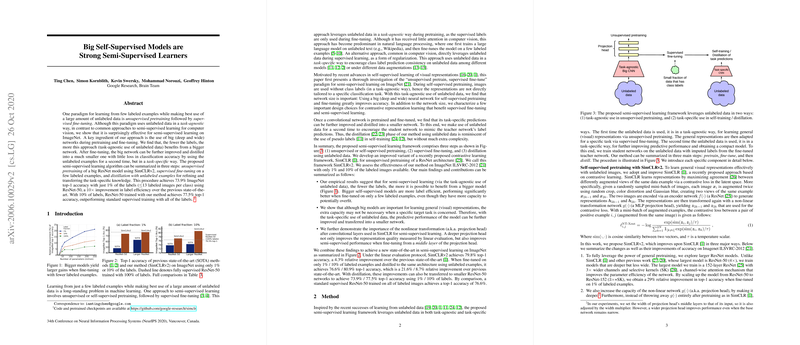Big Self-Supervised Models are Strong Semi-Supervised Learners
The paper "Big Self-Supervised Models are Strong Semi-Supervised Learners" by Chen et al. presents an examination of the semi-supervised learning paradigm, focusing on the application of large-scale self-supervised models to the ImageNet dataset. The authors utilize an unsupervised pretraining phase using SimCLRv2 followed by supervised fine-tuning of a large network, leveraging unlabeled data task-agnostically.
Summary of Methods
The authors propose a semi-supervised learning framework consisting of three crucial stages:
- Unsupervised Pretraining: Utilizing SimCLRv2, the framework first learns representations from large, unlabeled datasets using a big ResNet architecture.
- Supervised Fine-Tuning: The pretrained model is then fine-tuned using a small fraction of labeled examples, explicitly leveraging the previously acquired knowledge.
- Distillation with Unlabeled Examples: The fine-tuned large model is distilled into a smaller network using the unlabeled data again but targeted specifically at enhancing classification performance.
Key Findings
- Model Size and Label Efficiency: The empirical results suggest that larger models significantly boost label efficiency, showing greater improvements in classification accuracy as the number of labeled examples decreases. Specifically, a ResNet-50 obtained 73.9% top-1 accuracy with only 1% labels, indicating a tenfold enhancement over earlier methods.
- Projection Head: Incorporating a deeper projection head in SimCLRv2, and fine-tuning from its middle layer, further enhances both linear evaluation and fine-tuning performance. This decoupling was particularly beneficial in scenarios with fewer labeled examples.
- Secondary Utilization of Unlabeled Data: The task-specific distillation phase, akin to pseudo-labeling with a sophisticated architecture, significantly improves the model performance. This distillation yielded a state-of-the-art top-1 accuracy of 76.6% on ImageNet when using just 1% of the labeled data.
Numerical Results
The paper presents compelling numerical results:
- Using 1% of labeled data, a ResNet-50 model trained with this methodology achieves 73.9% top-1 accuracy, a remarkable improvement from the previous state-of-the-art at 63.0%.
- With 10% subset labels, the framework accomplishes a 77.5% top-1 accuracy, surpassing fully supervised training of ResNet-50 on the entire dataset.
- When distilled into smaller architectures, the relative improvement of the task-specific knowledge was consistent without significant reductions in classification accuracy.
Implications
Practical Implications: The efficacy of utilizing large-scale self-supervised learning for semi-supervised tasks has profound practical implications. Industries and research areas concerned with limited labeled data—such as medical imaging, satellite imaging, and other specialized fields—stand to benefit greatly. Efficient use of limited labeled data enables the rapid development of robust models without the prohibitive cost associated with accruing labeled datasets.
Theoretical Implications: From a theoretical standpoint, this research advances the understanding of how network scale and parameter efficiency intersect with unsupervised learning paradigms. The work underscores the importance of model capacity in leveraging unlabeled data for effective representation learning.
Future Directions
Future research avenues highlighted by these findings include:
- Exploration of more sophisticated task-specific distillation techniques.
- Improved architecture search for optimizing parameter efficiency alongside model capacity.
- Application and validation of the discussed techniques across varied large-scale datasets beyond ImageNet, assessing the generalizability and robustness across domains.
- Investigation into the underlying reasons for the efficacy of large-scale models in semi-supervised learning, potentially informing better regularization techniques.
The detailed analyses and promising results presented by Chen et al. reinforce the utility of large self-supervised models in semi-supervised learning settings, setting a benchmark for future research in the area.
